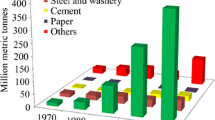Abstract
Metal contamination due to coal leaching has caused various detrimental health hazards in the vicinity of mining industries. To evaluate the release of metal upon weathering under natural condition, aqueous leaching experiments of three different coal samples, from three coalfields - Neyveli, West Bokaro and Makum, were carried out. These coalfields represent three contrasting geological settings. Concentration of Cu and Cr in West Bokaro, and Ni in Makum coal exceeds that of world range. Leachate from Makum coal is highly acidic and contains very high concentration of Fe, Ni, Pb, Mn and Cd. This is mainly caused due to the dominance of pyrite in coal. On the other hand, coals from other mines release near neutral to slightly alkaline leachate. Leachate quality is mainly controlled by the mineralogy, which is a manifestation of depositional environment. Therefore, proper care needs to be taken during storage and dumping of coal at Makum area in order to control the metal contamination.
Similar content being viewed by others
References
Banerjee N. N., Ghosh B. and Das A. (2000). Trace Metals in Indian coals. Allied Publishers, New Delhi, India.
Baruah B.P. and Khare P. (2010) Mobility of trace and potentially harmful elements in the environment from high sulfur Indian coal mines. Appl. Geochem., v.25, pp.1621–1631.
Chandra D. and Chakrabarti N.C. (1989) Coalification trends in Indian coals. Int. Jour. Coal Geol., v.13, pp.413–435.
Cohen A.D., Spackman W. and Dolsen P. (1984) Occurrences and distribution of sulphur in peat forming environments of Southern Florida. Int. Jour. Coal Geol., v.4, pp.73–96.
Equeenuddin SK.MD., Tripathy S., Sahoo P.K. and Panigrahi M.K. (2010) Hydrogeochemical characteristics of acid mine drainage and water pollution at Makum Coalfield, India. Jour. Geochem. Explor., v.105, pp.75–82.
Finkelman R.B. (1981) Modes of Gccurrence of Trace Elements in Coal. U.S. Geological Survey, Open-File Report 81–99.
Goodarzi F. (1988) Elemental distribution in coal seams at the Fording coal mine, British Columbia, Canada. Chem. Geol., v.68, pp.129–154.
Gupta A.K., Chattopadhyay B., Fyfe W.S. and Powell M. (2002) Experimental studies on three potassium-rich ultramafic rocks from Damodar valley, East India. Miner. Petrol., v.74, pp.343–360.
Karayigit A.I., Gayer R.A., Querol L. and Onacak T. (2000) Contents of major and trace elements in feed coals from Turkish coal-fired power plants. Int. Jour. Coal Geol., v.44, pp.169–184
Kumar A., Dayal A.M. and Padmakumari V.M. (2003) Kimberlite from Rajmahal magmatic province: Sr–Nd–Pb isotopic evidence for Kerguelen plume derived magmas. Geophys. Res. Lett., v.30, pp.2053–2056.
Moyo S., Mujuru M., Mccrindle R.I. and Mokgalakamatlala N. (2011) Environmental implications of materials leached from coal. Jour. Environ. Monit., v.13, pp.1488–1494.
Navale G.K.B. and Saxena R. (1989) An appraisal of coal petrographic facies in Lower Gondwana (Permian) coal seams of India. Int. Jour. Coal Geol., v.12, pp.553–588.
Nordstrom D.K. (1982) Aqueous pyrite oxidation and the consequent formation of secondary iron minerals: In: J.A. Kittrick, D.F. Fanning and L.R. Hossner (Eds.), Acid Sulfate Weathering. Soil Sci. Soc. Am. Spec. Publ., v.10, pp.37–56.
Sener M. (2007) Depositional conditions of the coal-bearing Hirka Formation beneath Late Miocene explosive volcanic products in NW central Anatolia, Turkey. Jour. Earth Syst. Sci., v.116(2), pp. 125–135.
Sidhanta B.K. (1986) The age of Neyveli lignite with reference to stratigraphy and palynology. Indian Minerals, v.40(3), pp.61–82.
Singh P.K., Singh M.P., Singh A.K. and Naik A.S. (2012) Petrographic and geochemical characterization of coals from Tiru valley, Nagaland, NE India. Energ. Explor. Exploit., v.30(2), pp.171–192.
Singh A.K., Singh M.P. and Singh P.K. (2013) Petrological investigations of Oligocene coals from foreland basin of northeast India. Energy Explor. Exploit., v.31, pp.909–936.
Swaine D.J. (1990) Trace Elements in Coal, Butterworths, London, 294p.
Tiwary R.K. and Dhar B.B. (1994) Environmental pollution from coal mining activities in Damodar river basin, India. Mine water Environ., v.13, pp.1–10.
Tiwary R.K. (2001) Environmental impact of coal mining on water regime and its management. Water Air Soil Poll., v.132, pp.185–199.
United States Environmental Protection Agency, (1994a) Test methods for evaluating solid waste, physical/chemical methods (SW-846) (3d ed., update 2B): Environmental Protection Agency National Center for Environmental Publications, Cincinnati, Ohio.
United States Environmental Protection Agency (1994b) Maximum contaminant level and secondary maximum contaminant level of inorganic parameters for public drinking water supplies, Washington (DC)
Ward C.R., Taylor J.C., Matulis C.E. and Dale L.S. (2001) Quantification of mineral matter in the Argonne premium coals using interactive Rietveld-based X-ray diffraction. Int. Jour. Coal Geol., v.46, pp.67–82.
Ward C. R. (2002) Analysis and significance of mineral matter in coal seams. Int. Jour. Coal Geol., v.50, pp.135–168.
Valkovic V. (1983) Trace elements in coal. Boca Raton: CRC Press.
Vaidyanadhan R. and Ramakrishnan M. (2010) Geology of India, v.2, Geological Society of India, Bangalore, 438p.
Vassilev S.V. and Vassileva C.G. (1996) Occurrence, abundance and origin of minerals in coals and coal ashes. Fuel Process. Technol., v.48, pp.85–106.
Yue M. and Zhao F. (2008) Leaching experiments to study the release of trace elements from minerals separates from Chinese coals. Int. Jour. Coal Geol., v.73, pp.43–51.
Author information
Authors and Affiliations
Corresponding author
Rights and permissions
About this article
Cite this article
Equeenuddin, S.M. Leaching of trace elements from Indian coal. J Geol Soc India 86, 102–106 (2015). https://doi.org/10.1007/s12594-015-0285-5
Received:
Accepted:
Published:
Issue Date:
DOI: https://doi.org/10.1007/s12594-015-0285-5




